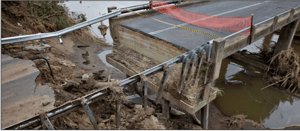Through the National Asset Centre of Excellence (NACOE) research program, ARRB is collaborating with the Queensland Department of Transport and Main Roads (TMR) to improve flood resilient solutions for bridge approaches on the State transport network.
Some of the nation’s worst ever recorded flood events occurred between March 2021 to October 2022, estimated to be in the order of a 1 in 200-year to 1 in 300-year average recurrence interval (ARI). During this period Queensland experienced a series of severe wet weather events including cyclones, major flooding, and excessive heavy rains causing disruptions of service to communities and significant damage to sections of the transport network.
The NACOE Resilient Bridge project aims to inform the prioritisation of investment in maintaining bridge approaches for the purpose of improving network resilience in the event of flooding. With a focus on investigating a sample of bridge approaches that are particularly at risk of being impacted by flood damage. NACOE aims to create an optimised risk management approach to the highest priority parts of the network.
The project focus is to develop a priority/risk assessment tool to assist in the identification of bridges on the critical routes of the network that are most at risk of flood damage. This will inform a proactive approach that may assist road agencies and asset managers facilitate more resilient bridge strategies.
The below images of Lockyer Creek bridge give an insight into the analysis undertaken as part of the project. Although flooding destroyed an embankment, the bridge structure appeared to be more resilient to damage.


Image Source: NACOE (2021)
To find out how ARRB can help to ensure bridges on your road network remain well-kept, maintained, and able to withstand natural disasters including flooding and cyclones, get in touch with us today via info@arrb.com.au.
